Almost the entire nasturtium plant is edible, including the flowers, leaves, stems, and immature seeds. The flavor for each part is similar, but still unique in their own ways.
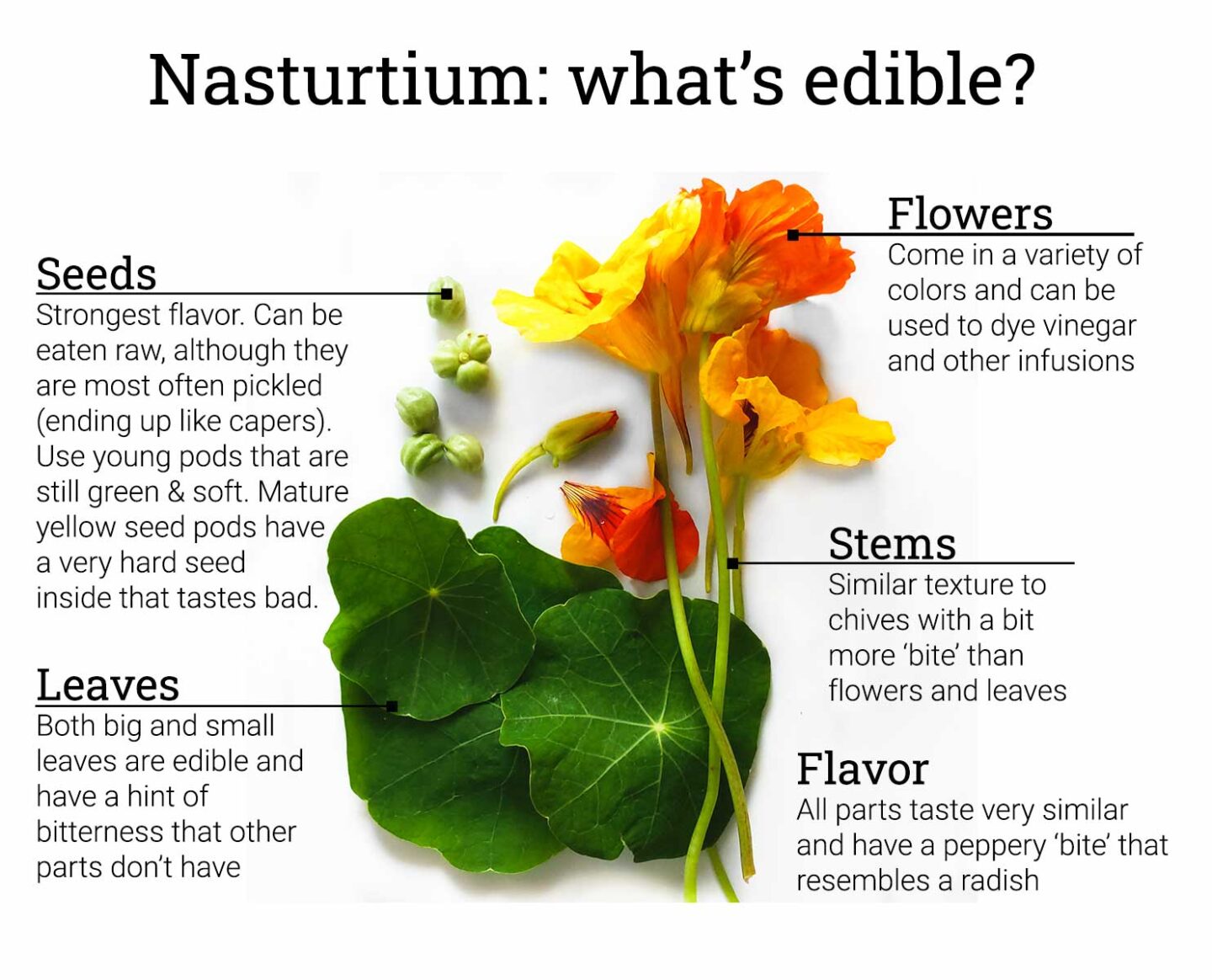
Nasturtium: what's edible?
All parts of the nasturtium plant are edible: flowers, leaves, stems, and young seed pods (mature seed pods have a very hard, unpleasant seed inside). All of these parts have a distinct peppery flavor similar to radishes. That bite is strongest in the seeds and lightest in the flowers. The leaves can sometimes have a very slight bitter taste that isn't present in the rest of the plant.
While the whole nasturtium plant is edible, each part has various applications, like using the stems in place of chives or using large leaves as wraps.
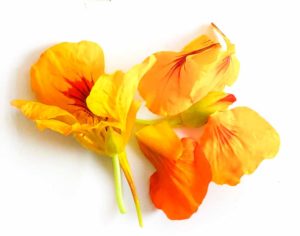
Flowers
Nasturtium flowers come in a variety of colors. The color can be an important consideration because petals will dye infusions. I grow the Kaleidoscope Mix and haven't noticed a flavor difference between the different colored flowers. They all taste very slightly floral with that spicy bite at the end.
Nasturtium flowers are best picked in the morning: after the dew has evaporated but before the midday heat sets in. The heat can make the flowers wilt. That being said, most of the time I pick mine at 6pm, right before I finish making dinner. They are usually a bit more delicate when I do this, but still work out just fine.
Wash the flowers gently in cold water to remove bugs and dry on a paper towel or salad spinner.
Best uses & recipes
- Salad: use whole flowers or pull the petals apart. Add to the salad as a garnish instead of mixing them in with the dressing.
- Vinegar: a nasturtium-infused vinegar is peppery and works great in salad dressings or anything that benefits from a splash of vinegar. It's also a bright red-orange color that looks cute for gifts.
- Salt: dry the flowers (leaves work too), then crush and mix with sea salt. Not only will it be pretty - it adds a unique peppery flavor to a dish. I use this as a finishing salt.
- Vodka / tequila: infuse alcohol with nasturtium flowers for a unique take on classics like a bloody mary or margarita.
- Garnish: the flowers make pretty garnishes on appetizers, charcuterie boards, pasta, and pretty much anything you can think of.

Leaves
Nasturtium leaves, both large and small, are completely edible. The young leaves are usually more tender than the larger ones, but that's not always the case. In the spring and early summer, I notice the large leaves are just as tender as the small ones. But later in the season, and especially in the fall, they are tougher.
The leaves have a generic green plant-like taste (like a lot of salad greens), with the sharp peppery bite that shows up several seconds later. The leaves can sometimes have just a slightly bitter taste on the finish as well. I can't taste a difference between the small and large leaves.
How to use nasturtium leaves
Pick the leaves any time of day. You might want to pick only small or only large ones, depending on the use. For example, small leaves can be used whole in a salad, whereas large ones work well for stuffing. Give them a good wash in cold water. They are quite sturdy and will hold up in a salad spinner.
Best uses & recipes
- Salad greens: use leaves whole or chopped for salads. Since nasturtium leaves have that peppery bite, you may want to mix in other more mild greens. Their peppery flavor goes well with goat cheese, fresh and dried fruits.
- Replace spinach: anywhere spinach is used, you can replace some (or all) of it with nasturtium leaves. This includes things like lasagna, minestrone, creamed spinach, quiche, quinoa or veggie patties, and spinach artichoke dip.
- Pesto: use the leaves to make a unique pesto to use on pasta, bread, or swirl into some minestrone. You can also use half basil and half nasturtium leaves for a more classic flavor.
- Replace grape leaves: large nasturtium leaves get as big as grape leaves and can easily be used for things like greek dolma.
- Muffin tin liner for mini quiches
- Salt: in addition to flowers, leaves can be dried and crushed into a gourmet salt.
- Infusions: leaves can also be used for infusions. The flavor will be similar to the flower infusions, and they don't impart a green color.

Stems
Nasturtium stems are crisp, yet tender. They are very similar to the texture of fresh chives. The stems can be used to replace chives in any recipe where you want to add nasturtium's characteristic bite. For example:
- As a garnish: baked potatoes, pasta, gratins, stir fry, garlic bread, salad, and nearly anything else
- Add to pesto: add to any recipe from a traditional basil pesto to a nasturtium-leaf pesto
- Fold into an omelet: the leaves and flowers can be added as well. Check out this herbed omelet with halloumi and nasturtiums.
- Sandwiches: add chopped stems to any sandwich for a unique flavor (mix in with mustard or sprinkle on top of cheese)
- Compound butter that gets used on bread, fresh grilled corn on the cob, etc

Seeds
Nasturtium seed pods are also edible and have the strongest flavor. Seed pods grow in groups of three and hide on long stems under the foliage. Pick them anytime they are green and still slightly soft. Avoid the mature yellow ones that have dried out (which contain a very hard, unpleasant tasting seed).
The seeds have the strongest bite, often stronger than most people want. However they mellow out when pickled and make an excellent replacement for capers (get pickling recipe). Try them in chicken piccata, potato-lentil salad, or pasta with garlic caper butter.

Varieties
All nasturtiums are edible - just like all tomato varieties are edible. Nasturtium plants are not poisonous to people (but could be for cats and dogs).
In fact, several major seed distributors (Burpee, Johnny's Selected Seeds, and Baker Creek Heirloom) all mention the edibility of nasturtium at the top of the nasturtium varieties pages.
"Nasturtiums have delicious flowers and leaves, perfect for salads and soups, and this plant makes a world-class pesto!" - Baker Creek Heirloom
"A popular edible flower, the trumpet-shaped blooms of nasturtium have a sweet, mildly spicy flavor, making a colorful garnish or addition to salads. The peppery-tasting foliage is also edible." - Johnny's Selected Seeds
"Cute as can be, nasturtium bloom in cheerful colors and are prized by cooks for their slightly peppery flavor — a delicious ingredient in stir fries, pesto and omelets, as well as a very pretty salad garnish." - Burpee
If you want to grow your own nasturtium, try one of these varieties.
- Alaska mixes
- Bloody mary
- Cherry rose jewel
- Empress of India
- Orchid cream
- Tip top rose
- Tom thumb black velvet
- Whirly bird rose
- Yeti
Edible flower ideas
Try some nasturtium pesto, chive blossom vinegar, or candied lilacs (which last a year, by the way!), for interesting spring and summer treats.

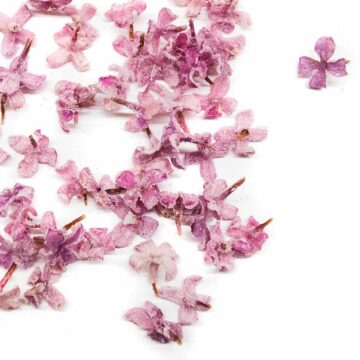
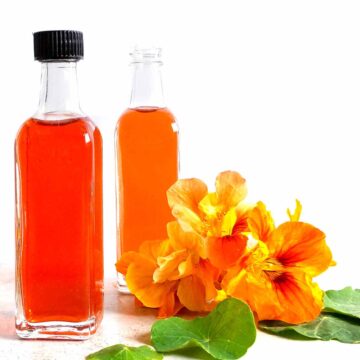
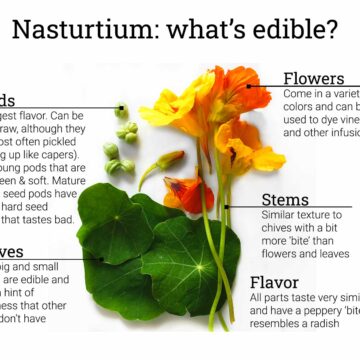
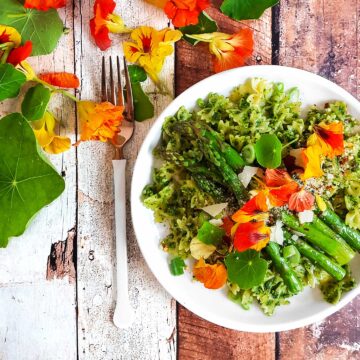
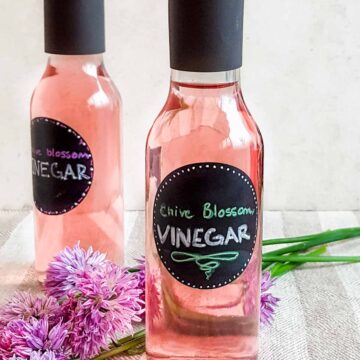
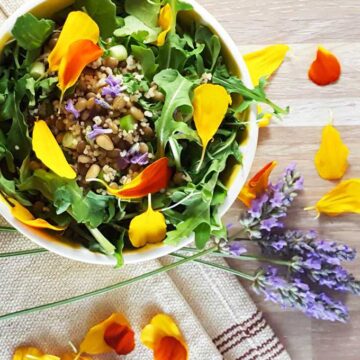
Caroline Doyle says
Hi, do you know if nasturtium leaves and stems will freeze, like spinach, to preserve some and keep using them over winter?
Veronica T says
What a great question, and I can't believe I haven't tried that. I will freeze some next week and use them in winter to be able to report first hand. However, my suspicion is they will act very similarly to spinach (like you mentioned). I would also assume, like spinach, that they will be wet and wilty after freezing, and will need to be used in dishes that can accommodate that. If you do it, please stop back and report what you find. I'll also update the post this winter 🙂
Mia says
I'm adding nasturtium leaves to my green smoothies, and using as a replacement for spinach in salads. Hardly peppery at all. Not only are they fresh picked directly before using, they are also cheaper than buying spinach greens 🙂 That makes them a winner.
Vee says
Thanks for sharing these great ideas. You have a very good point: nasturtium makes a great spinach substitute 🙂
JM says
Hi, I was wondering if I could add the nasturtium seeds whole to a red lentil soup? I often add chickpeas but was wondering if it would be too much of a flavour pop to add those fresh green nasturtiums ?
Vee says
I have never done that, but can give it a try when mine go to seed this year. My gut says it won't work well, but I might be pleasantly surprised.
Marion says
Great info. Lots of ideas, I'llhave totrymakingthe vinegar.
I also use them as a groundcover, although last summer I ended up losing my wheelbarrow when it was temporarily grown over lol. The flowers are also a welcome snack when out walking the dog.
Mr Roy T Valerio says
There are many varieties of nasturtium. Which ones are edible? There's the Canary Creeper, Alaska Mixed, Jewel Mix, Whirlybird Mix, Salmon Baby and Tom Thumb Black Velvet. Would appreciate assistance in letting me know which ones are edible.
Vee says
Great question! All types of nasturtium are edible - they are not poisonous to humans (although it's possible they are toxic to cats and dogs). I'll update the post with links to different varieties and cite sources for the edibility.
Gloria Foster says
Great information about nasturtiums. I will try to stuff them. Thanks
Emily says
Same I didn't find this sooner mine are dying back and had left them for the caterpillars, black fly and lady bugs. Remember for next year
Vee says
At least the bugs got a feast 🙂
Mita says
This is my favorite plant to grow from seeds and hang them in my porch and deck and they flow so elegantly. I love diffrentcolor of the leaves (some speckled white) and colors of the flower. But never ate them. Lovely!
Jennifer says
This is amazing! This helps us to unlearn some ideas we have been taught around food and give us a little power back in creating edible treats from our gardens 🙂
Vee says
Glad I can help! Every time I add a plant to my yard, I try to pick something edible. My next plant might be a hibiscus 🙂
Sherry says
Do you have any hints to find the seeds? I have trailing nasturtium in a large window box in front and have yet to find one seed🧐 and I've looked these plants over. lol
Vee says
I wonder if the plant hasn't gone to seed yet? Or are there critters taking them for snacks perhaps? Here's a post that talks more about the seeds, as well as a link to a video. I hope that helps!
Peter Gillooley says
Thanks what great ideas
Felicia says
I love learning and exploring. This info is just wonderful. Thanks.